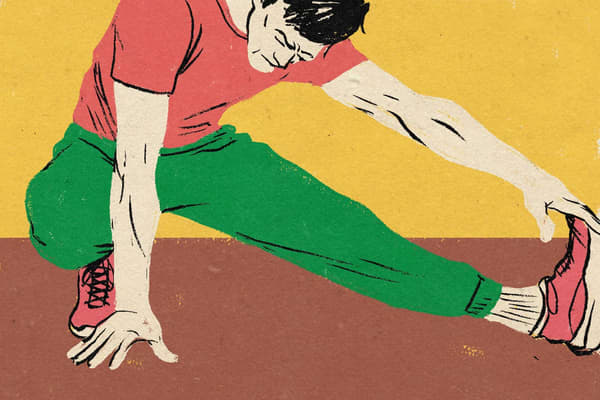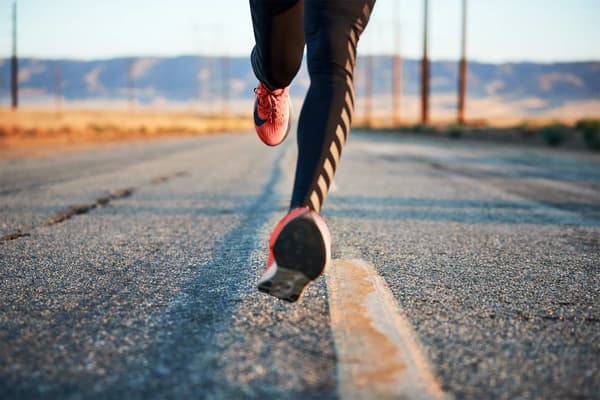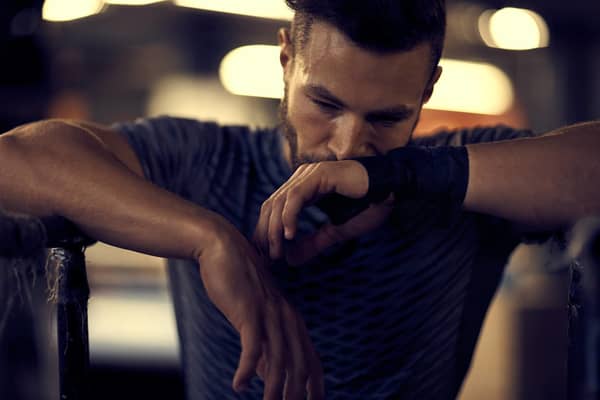Important Signs of Heatstroke Not to Ignore, Say Experts
Health & Wellness
Stay safe by looking out for these key heatstroke symptoms.

Warm, sunny days may motivate you to lace up your sneakers and head outside for a workout. While that's generally a great idea, it's important to know the signs of heatstroke before heading out for a hot-weather workout to stay safe and avoid heat-related illnesses.
What is heatstroke?
Heatstroke is a serious heat-related illness that happens when the body can no longer regulate its core temperature, according to the Centers for Disease Control and Prevention. It can be fatal if it's not treated quickly. Heatstroke usually happens when the body temperature is above 40 degrees Celsius, according to the National Institutes of Health. When the body is experiencing heatstroke, core temperatures can reach 41 degrees Celsius or higher, according to the CDC.
The NIH noted that there are two types of heatstroke: classic and exertional. Classic heatstroke typically affects people who are 65 years (and older) with chronic medical conditions, whereas exertional heatstroke typically affects people engaging in strenuous exercise in hot or humid conditions.
"Certain medications and medical problems like malnutrition, cancer, anaemia and even diabetes could be an increased risk factor", said Randolph DiLorenzo, MD, internal medicine doctor and medical director of Northwell Health Syosset Hospital. While you may be predisposed or more vulnerable to suffering from heatstroke if you're just breaking into a fitness routine, more seasoned athletes aren't off the hook, either.
Heatstroke Symptoms
According to the CDC, symptoms of heatstroke include:
- Confusion, altered mental status, slurred speech
- Loss of consciousness (coma)
- Hot, dry skin or profuse sweating
- Seizures
- Very high body temperature
It's important to be able to recognise these symptoms in someone else. "Heatstroke causes central nervous system—CNS—dysfunction, causing symptoms like confusion, combativeness, altered behaviour, altered consciousness and coma", said Douglas Casa, PhD, CEO of the Korey Stringer Institute and a professor in the Department of Kinesiology at the University of Connecticut. "If someone is in the throes of a heatstroke or on the verge of heatstroke, and they are confused and irrational, they are not going to be able to accurately judge themselves".
Early Signs of Heatstroke
You might be able to catch heatstroke if you notice early warning signs. "Early warning signs happen before the CNS dysfunction occurs, and before someone is super-hot", Casa said. The biggest sign? "When things feel 'off' on any given day", he said. For example, if you're doing your normal workout, but for some reason it feels a lot harder or just different to normal (in a bad way).
"Maybe you haven't slept as well, or you're coming back from illness or an injury. When things feel 'off'—maybe you're feeling dizzy or light-headed or nauseous and you had never felt this way before, and now something is off—those are early warning signs you need to listen to", Casa said. Pushing through in those situations is what can get you into dangerous territory.
Other early signs of heatstroke include symptoms of heat exhaustion, a less severe heat-related illness that is a precursor to heatstroke, according to the NIH.
Heatstroke vs Heat Exhaustion
Heat exhaustion is another heat-related illness that happens when you lose excessive sweat and salt, per the CDC. "Heat exhaustion may cause high heart rate, dehydration, trouble walking and feeling faint", DiLorenzo said.
Symptoms of heat exhaustion are similar to early signs of heatstroke, the NIH noted. These include:
- Headache
- Nausea
- Dizziness
- Weakness
- Irritability
- Thirst
- Heavy sweating
The biggest difference between heat exhaustion and the more dire heatstroke? "With heatstroke, you start behaving differently", DiLorenzo said. "You experience an alteration in consciousness, along with significant nausea and/or headache, and that can lead to a coma or seizure".
If you notice symptoms of heat exhaustion, it's important to give your body a chance to cool down so that your body temp doesn't keep increasing and put you into heatstroke territory.
"Heat exhaustion can progress and that can lead to heatstroke", DiLorenzo said. "If you notice any of these signs, stop what you're doing, go into a cool environment, drink water and rest for a little while. Most people will recover".
RELATED: This Is Exactly How Much Water You Should Drink Every Day, According to Experts
What to Do If You Notice Signs of Heat Illness
It's imperative to take action as soon as those symptoms of heat exhaustion come on so that it doesn't progress to heatstroke.
"Generally speaking, you want to back off on intensity and try to remove yourself from the environment", Casa said, adding that "the most important thing is to lower the intensity of the activity" since that's what will immediately stop your body temperature from increasing further.
Next, get to a cooler place. An air-conditioned room or vehicle would be great, Casa said, but that might not always be possible. Luckily, there are a few other little things you can do to help bring your body temperature back down into a safe range.
"If you're in direct sun or using hot equipment, stop using it and seek shade", Casa said. And drink water. "Hydration decreases the rate of rise of your body temperature during intense exercise in the heat", Casa said. "Your body temperature can be as close to a half degree higher for every 1 percent of body mass lost via sweat". So, replacing those lost fluids (and electrolytes!) can help your body regulate itself again.
And, remember, don't forget to let someone know you're not feeling well. In case things progress, it's important that someone else knows and can step in to get you help if necessary.
"If you see someone really behaving as though they are completely exhausted—they can't get up, they have difficulty drinking, they are experiencing any kind of altered consciousness, they look like they are going to pass out—these are all emergencies and you should call the emergency services", DiLorenzo said. "Sometimes when we see heat illness in the hospital, we'll give you IV fluids that are cooled. To rapidly cool someone who has a high core temperature, we may also put ice under the arms and put a fan on them", he said.
After you've called for help, try to cool the person down while you wait, Casa said. "Put them in a lake, stream or cold shower, or place cold wet towels on them". He added that you have about 30 minutes to cool the body (below 40°C) before severe complications start to set in. Again, take these measures after you've contacted a medical professional and are waiting for them to arrive.
How to Prevent Heatstroke
There are five key things you can do to reduce risk of heatstroke while exercising in the heat, according to Casa.
1.Acclimatise to the heat.
"This is probably the most important", Casa said. "Heat acclimatisation is the actual physiological changes your body goes through in the first week or two of exercise in the heat".
By allowing your body to gradually get comfortable working in the heat, you'll reduce strain on the heart and other organs, and your sweat rate will improve, making your body more efficient at cooling itself, according to the CDC. The best way to do it is to increase your workload in a hot setting gradually over the course of one to two weeks, getting at least two hours of heat exposure per day (at once or broken into two one-hour chunks), according to the CDC.
"You can get 75 to 80 percent of the physiological adaptations in the first five days", Casa said.
To gradually ease into it, Casa recommends making modifications—longer rest breaks, scaled-back intensity, opting for cooler times of the day—in the beginning so that you're not going from zero to 100. As the days go on and you begin to adapt to the warmer temperatures, you can then begin to increase the intensity slowly.
2.Hydrate.
Remember, hydrating can be protective against heat exhaustion and heatstroke. Drink throughout the day and keep track of how much you're taking in. "Check your urine colour throughout the day. It should be light like lemonade, not dark like apple juice", Casa said. "You always want to start exercising hydrated".
3.Add more rest time when it's hot and humid.
On especially hot and humid days, tweak your workouts so that you have longer rest periods. This will help bring down the intensity of the exercise, which Casa said is important for avoiding heat illness.
4.Modify equipment and clothing.
"If it's a brutal day, maybe don't have equipment on and don't do contact activities so that it's not as oppressive", Casa said. DiLorenzo recommended wearing "loose, lightweight and light-coloured clothing", to stay as cool as possible on a hot day.
5.Get sufficient sleep.
"Sleep can be protective", Casa said. "People seem to be able to handle more activity when they have less fatigue". He calls this an "X-factor", and added that being ill can be another one. These things may not seem related to heatstroke, but they change how intense a workout feels, and can increase that part of the equation without you realising it.
Words by Amy Marturana Winderl





